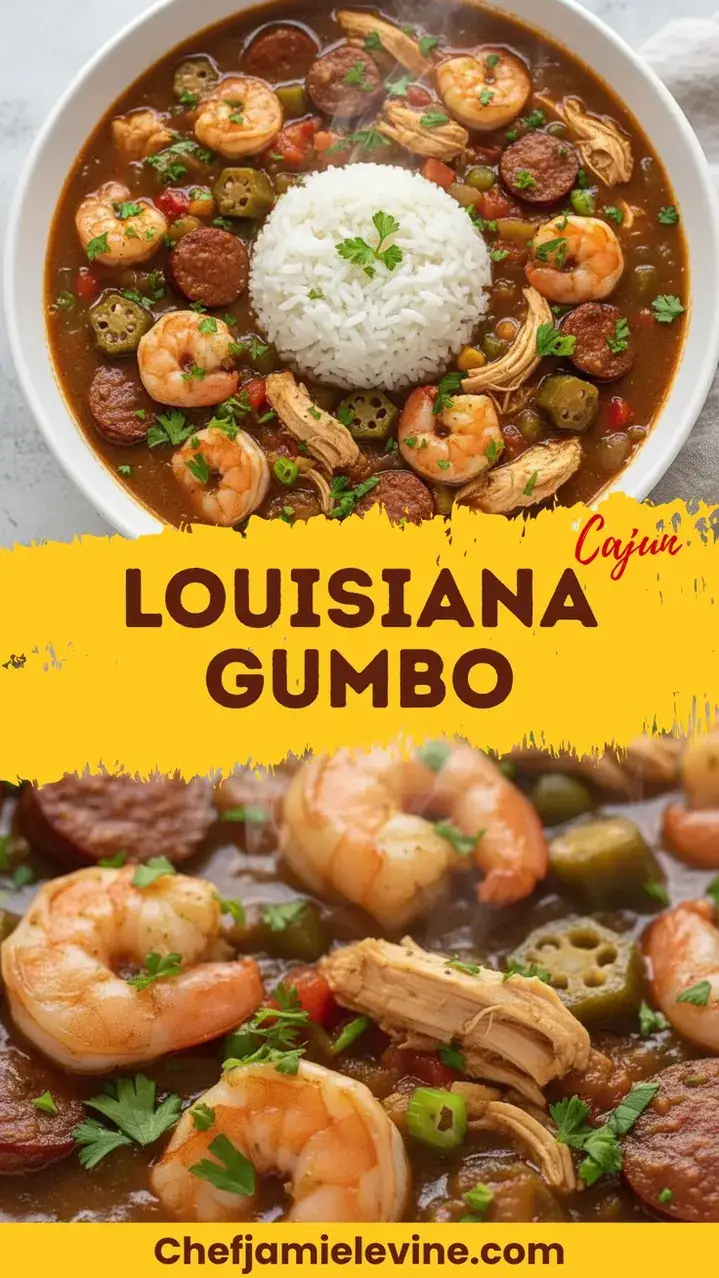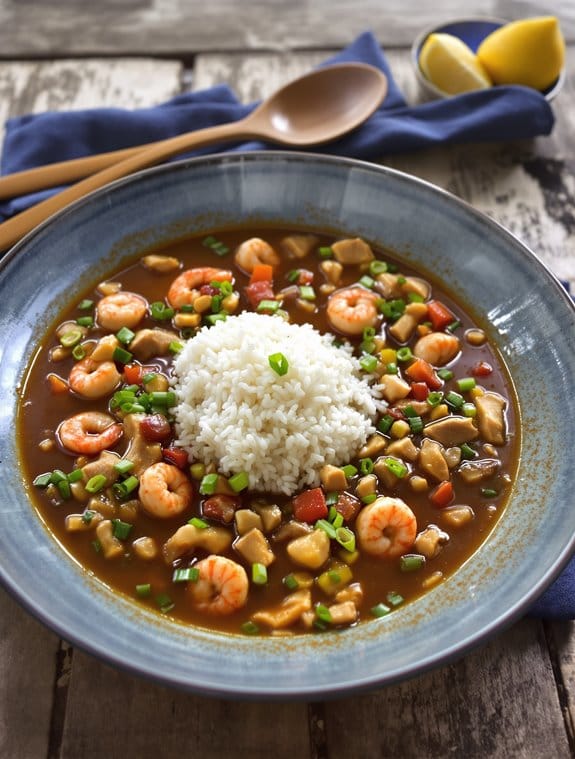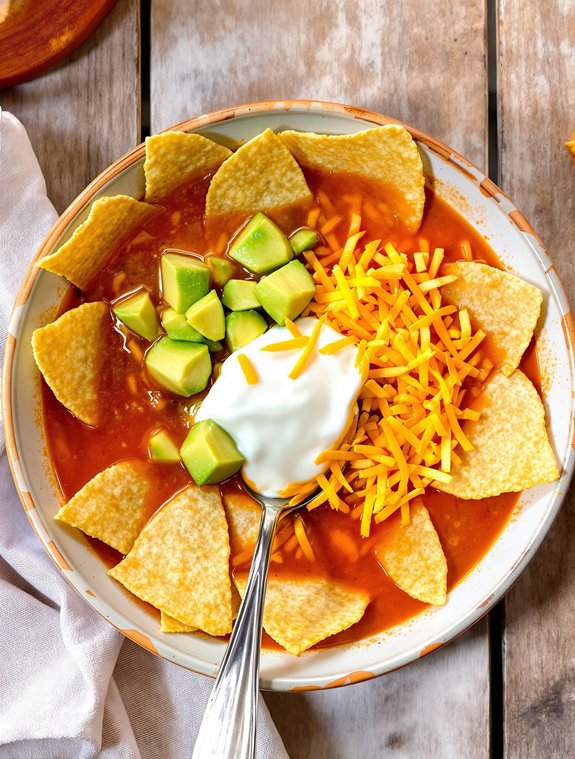Why You’ll Love this Authentic Louisiana Gumbo
There’s nothing quite like the rich aroma of a true Louisiana gumbo simmering on the stove.
This authentic recipe brings the heart of Cajun country right to your kitchen, with its perfect dark roux and vibrant blend of vegetables.
I love how versatile it is—toss in shrimp, chicken, or whatever protein speaks to you.
The magic happens in those 15 minutes of constant stirring, transforming simple flour and oil into a nutty, complex base that defines real gumbo.
Trust me, once you’ve mastered this deeply flavorful comfort food, store-bought versions will never satisfy again.
What Ingredients are in Authentic Louisiana Gumbo?
Authentic Louisiana gumbo starts with the foundation of a proper dark roux, the soul of this iconic dish. The magic happens when simple flour and oil transform into a rich, nutty base that gives gumbo its distinctive flavor and color.
What makes this recipe truly special is the “holy trinity” of Cajun cooking—bell peppers, onions, and celery—which adds layers of flavor that simply can’t be replicated with shortcuts. I’m always amazed at how these humble ingredients come together to create something so deeply satisfying.
- 1/2 cup vegetable oil
- 1/2 cup all-purpose flour
- 1 large onion, diced
- 1/2 cup chopped fresh parsley
- 1/2 cup chopped celery
- 1/2 cup chopped green bell pepper
- 1/2 cup chopped red bell pepper
- 1/2 cup sliced scallion
- 6 cloves minced garlic
- 4 cups chicken broth
- 1 teaspoon salt
- 1 teaspoon creole seasoning (Tony Chachere’s recommended)
- 2 pounds of protein (shrimp, chicken, or other seafood)
- White rice for serving
When shopping for your gumbo ingredients, freshness matters greatly, especially with the vegetables and seafood.
While the recipe notes that okra is optional (and personally, I understand the hesitation—it’s definitely a love-it-or-hate-it ingredient), many traditional gumbos do include it for both flavor and its natural thickening properties.
The protein is wonderfully flexible—don’t be afraid to mix and match shrimp, chicken, crab, or even sausage based on what’s available or what you’re craving.
Just remember that the quality of your creole seasoning will greatly impact the final flavor, so if possible, seek out authentic brands like Tony Chachere’s rather than generic alternatives.
How to Make this Authentic Louisiana Gumbo

The heart of any authentic gumbo lies in the roux, and this recipe is no exception. Start by combining 1/2 cup vegetable oil and 1/2 cup all-purpose flour in a large stockpot over medium-high heat.
This is where patience becomes your greatest virtue—you’ll need to stir almost constantly for about 15 minutes until the mixture transforms into a deep, dark brown color that’s just shy of black. Think of it as somewhere between chocolate and coffee grounds.
This roux-making process isn’t just cooking; it’s a meditative practice that connects you to generations of Louisiana cooks who’ve stood over pots, wooden spoons in hand, coaxing flavor from the simplest ingredients.
Once your roux reaches that perfect darkness, it’s time to add the aromatic vegetables that will build your gumbo’s foundation. Add 1 large diced onion, 1/2 cup chopped fresh parsley, 1/2 cup chopped celery, 1/2 cup each of chopped green and red bell peppers, 1/2 cup sliced scallions, and 6 cloves of minced garlic.
Cook these vegetables for about 10 minutes, stirring regularly, until they become tender and have released their flavors into the roux. The kitchen will fill with an incredible aroma at this point—earthy, savory, and deeply complex.
Next, pour in 4 cups of chicken broth along with 1 teaspoon salt and 1 teaspoon of creole seasoning (Tony Chachere’s really does make a difference here). Cover the pot and let it simmer for 15 minutes, giving it an occasional stir to prevent sticking.
The final touch is adding your chosen protein. Whether you opt for 2 pounds of plump shrimp, tender chicken, or a combination of seafood, this is where your gumbo becomes truly yours.
Add your protein and simmer for an additional 10 minutes until everything is perfectly cooked through. If you’re using crab claws or blue crab halves, you’ll want to extend this cooking time slightly to guarantee they’re thoroughly done.
When serving, ladle this rich, complex stew over a mound of steaming white rice. The contrast between the deeply flavored gumbo and the clean, simple rice creates that perfect balance that makes this dish so beloved throughout Louisiana and beyond.
Authentic Louisiana Gumbo Substitutions and Variations
While mastering the traditional gumbo recipe is rewarding, Louisiana cooking has always embraced creativity and adaptation. I’ve found that substituting turkey or duck for chicken adds a richer flavor profile.
Don’t have fresh bell peppers? Roasted ones work beautifully, adding a smoky depth.
For seafood variations, try adding oysters during the last five minutes of cooking—they’ll plump up perfectly without getting rubbery.
Vegetarians aren’t left out either; mushrooms and extra okra create a hearty alternative.
My Cajun grandmother would roll her eyes, but I sometimes use a store-bought roux when time’s tight.
The gumbo gods may frown, but dinner still gets on the table.
What to Serve with Authentic Louisiana Gumbo
Properly serving authentic Louisiana gumbo demands more than just ladling it over rice, though that’s certainly the essential foundation.
I like to accompany my gumbo with warm, crusty French bread for sopping up that rich, dark roux. A simple side salad with vinaigrette adds a delightful contrast to the deeply savory stew.
For drinks, nothing beats an ice-cold beer or sweet tea.
Want to go all out? Serve traditional Southern cornbread on the side—slightly sweet and crumbly, it’s divine when dunked into the broth. Some folks even add a small scoop of potato salad right in the gumbo bowl, a quirky regional tradition worth trying.
Final Thoughts
Making authentic Louisiana gumbo truly becomes a journey into Southern culinary tradition—one that rewards patience and attention to detail.
That dark roux, nearly black but not burnt, is your foundation for flavor that can’t be rushed. I’ve found the joy of gumbo isn’t just in eating it but in the meditative stirring, the layering of ingredients, the way your kitchen fills with aromas that tell stories of Louisiana.
Whether you choose shrimp, chicken, or a combination, remember that gumbo welcomes creativity while honoring tradition.

Louisiana Gumbo
Ingredients
Equipment
Method
- In a large stockpot over medium-high heat, combine vegetable oil and all-purpose flour to create a roux.
- Stir the roux constantly for about 15 minutes until it transforms into a deep, dark brown color (between chocolate and coffee grounds).
- Add the diced onion, chopped parsley, chopped celery, chopped bell peppers, sliced scallions, and minced garlic to the roux.
- Cook the vegetables for about 10 minutes, stirring regularly, until they become tender and have released their flavors into the roux.
- Pour in the chicken broth, salt, and creole seasoning. Cover the pot and let it simmer for 15 minutes, stirring occasionally to prevent sticking.
- Add your chosen protein (shrimp, chicken, or other seafood) and simmer for an additional 10 minutes until thoroughly cooked.
- Serve the gumbo ladled over steaming white rice.



